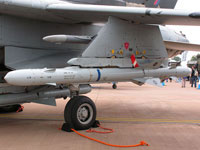ALARM
stands for Air-Launched Anti-Radiation Missile designed primarily to
destroy enemy radars for the purpose of Suppression of Enemy Air
Defence (SEAD).
It was introduced into UK Royal Air Force Service in the early 1990s.
The missile
is launched at low level near the suspected site of an enemy radar
and, after launch, rapidly climbs to about 12,000 m.
At this height, a small parachute opens and the missile descends
earthwards while the on-board radar searches the broadband for
emissions from enemy radar.
Once a target has been identified, the motor is re-ignited and the
missile makes a supersonic dive onto the target. The total RAF buy in
the first manufacturing run was believed to be some 750 missiles.
Since its original entry into service, radars have become increasingly
more sophisticated in their ability to avoid detection and attack by
anti-radiation weapons such as ALARM.
|
ALARM Specifications |
|
Type |
Air Launched
Anti-Radiation Missile |
|
Manufacturer |
BAe Systems |
|
Weight |
265kg |
|
Warhead |
146lbs (66kg) direct fragmentation with
proximity/contact fuse |
|
Length |
4.3m |
|
Diameter |
23cm |
|
Performance |
Speed Mach 1 +, range
93km, guidance passive radar seeker |

